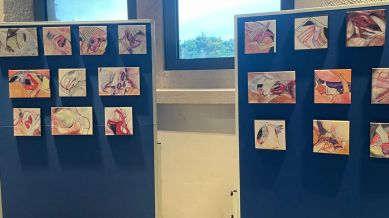Click here to join Express Pune WhatsApp channel and get a curated list of our stories
When medicine meets art: Pune neurosurgeon’s paintings capture brain’s hidden beauty, its complexities
Neurosurgeon Dr Jaydev Panchwagh’s artwork reflects how he is inspired by the interplay of light and shadow within the human brain during a surgery.

Artists have always been fascinated by how light reflects off different surfaces, be it shiny objects or the depth of dark caves. For Pune-based neurosurgeon Dr Jaydev Panchwagh, the same play of light and shadow exists within the human brain when illuminated during surgery. This inspired him to merge aesthetic and scientific perspectives through his paintings.
An initiative that led the doctor to embark on his artistic journey five years ago has grown into a collection of over 60 paintings, which were recently displayed at an international conference in Mumbai. The exhibit caught the eye of Dr Michael Lawton, President and CEO of Barrow Neurological Institute—also known for his involvement with Elon Musk’s Neuralink. Soon after, the idea of creating a painting based on one of Dr Lawton’s surgeries took shape.
monthly limit of free stories.
with an Express account.
“Arteriovenous malformation of the spinal cord is one of the most difficult neurosurgeries. Such was the complexity that it took 10-12 hours to create a single painting based on Dr Lawton’s surgery. This was the first time that I have painted someone else’s surgery, and I am happy that it was of one of the world’s leading neurosurgeons,” Dr Panchwagh, Chairman of Synapse Brain and Spine Foundation and founder member of the Indo German Neurosurgery Foundation, told The Indian Express. He added that he was pleasantly surprised that his artwork had found appreciation from various neurosurgeons across India and the world.
Among Dr Panchwagh’s collection is a unique painting that captures the tangle of abnormal blood vessels in the brain, in shapes and shades of red, transforming as if alive. “The aim is to reveal the hidden beauty of vital brain structures and the remarkable complexity of their functions,” he said.
With modern endoscopy, doctors can look deep inside the brain to understand its intricate architecture and its striking visual patterns, according to Dr Panchwagh. “Imagine the excitement of unfolding these internal landscapes, not just through science, but also through art,” he said, explaining how he entered the world of art. “I have sketched several drawings during my ongoing research. So, taking to painting was a natural extension,” he added.
Trigeminal Neuralgia Awareness Month
Dr Panchwagh also highlighted the significance of his endeavour in light of October being observed as Trigeminal Neuralgia Awareness Month, with October 7 marked as Trigeminal Neuralgia Awareness Day.
This rare and debilitating facial pain disorder affects the trigeminal nerve and is often described as a disease causing the most severe pain—sometimes referred to as the “suicide disease” due to its severity. The condition recently gained public attention when actor Salman Khan spoke about his experience with it.
“There can be severe shooting pain attacks on one side of the face, gums or forehead that can even be triggered by touching the face, breeze of air, brushing teeth, opening the mouth, and so on. Unfortunately, this pain is often misdiagnosed,” Dr Panchwagh said.
Some of his paintings displayed at a recent exhibition in Germany were sold to raise money for patients suffering from Trigeminal Neuralgia and Hemifacial spasms.
Click here to join Express Pune WhatsApp channel and get a curated list of our stories